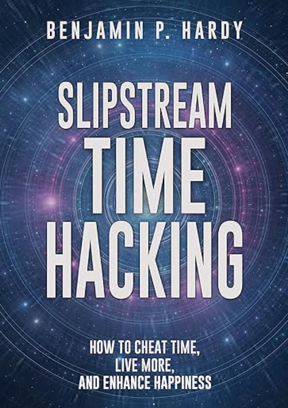Review of Slipstream Time Hacking: How to Cheat Time, Live More, and Enhance Happiness

Most of us think about time in a linear way—counting hours, days, and years. Before reading Slipstream Time Hacking, time was something in short supply that I struggled to manage or optimize for productivity. Written by Dr. Benjamin Hardy, an organizational psychologist and bestselling author, this book changed my thinking. Time isn’t just about how long things take; it’s about how far we go.

Key Concepts
Time = distance traveled
Hardy advises us to measure progress by meaningful milestones rather than clock time. We’ve all experienced moments of flow when we surprise ourselves by accomplishing more than we thought possible in a short amount of time. Flow states are distance traveled and accomplishments earned.
- What small or large wins happened for you yesterday? Last week? In the past month?
The faster we chase our goals, the more time seems to slow down
Hardy brilliantly links Einstein’s theory of relativity to personal growth. When we align our actions with our vision, we feel time expands. Success isn’t about working more intensely but about moving with purpose and passion toward what truly matters.
- Can you remember when you experienced the expansion of time?
Slipstreams and wormholes as metaphors
The idea of “wormholes”—those opportunities that dramatically accelerate our progress—fascinates me. I find myself searching for slipstreams I can step into to make my work feel effortless. These shortcuts aren’t happy accidents or strokes of luck—they’re strategic opportunities we can intentionally create.
- What occurred in the past month that dramatically shortened your path to success?
3 Concrete Examples
Utilizing Slipstream Pathways: Hardy redefines the concept of slipstreams (from science fiction) as “optimal pathways toward a desired destination.” He explains that following proven strategies, mentors, or models can accelerate success just as drafting in cycling reduces resistance.
Time Dilation Through Rapid Learning and Technology: The book explains that technological advancements allow people to progress hundreds of times faster than in the past, representing a real-world example of time dilation. (See Accelerate Your Learning)
The Gift of Time Through Presence: Being fully present—physically and emotionally—creates a sense of expanded time. Hardy emphasizes that while time spent with others is precious, the time we create for others is priceless.
Summary
This book is a must-read if you’ve ever felt stuck or like progress is taking too long. It’s an easy-to-understand and unusual mix of physics, philosophy, and practical tips for getting “unstuck” from regular time. Hardy reminds us that we can intentionally design moments of exponential growth in our professional lives. When we do, normal productivity rules seem to bend, allowing us to advance further with less resistance.

⏰ 3 Actionable Steps You Can Take Today To Bend Time
- Identify your “slipstreams” — Take 15 minutes to reflect on the gains you’ve made recently. List the activities, relationships, and environments where you made rapid progress with minimal resistance. These are your natural slipstreams. Schedule more time in these zones to experience time dilation.
- Create a morning “time wormhole” — Wake up 30 minutes earlier than usual and dedicate this time only to your most important goal. No distractions, no multitasking. Notice how much progress you can make in this focused period compared to your normal scattered approach.
- Measure distance, not time — For your next project, define clear milestones instead of deadlines. At the end of each day, ask “How far did I travel today?” rather than “How much time did I spend?” This subtle shift can lead to a significant change in your relationship with productivity.
I’d love to hear your thoughts if you’ve tried any of these approaches or read the book!
